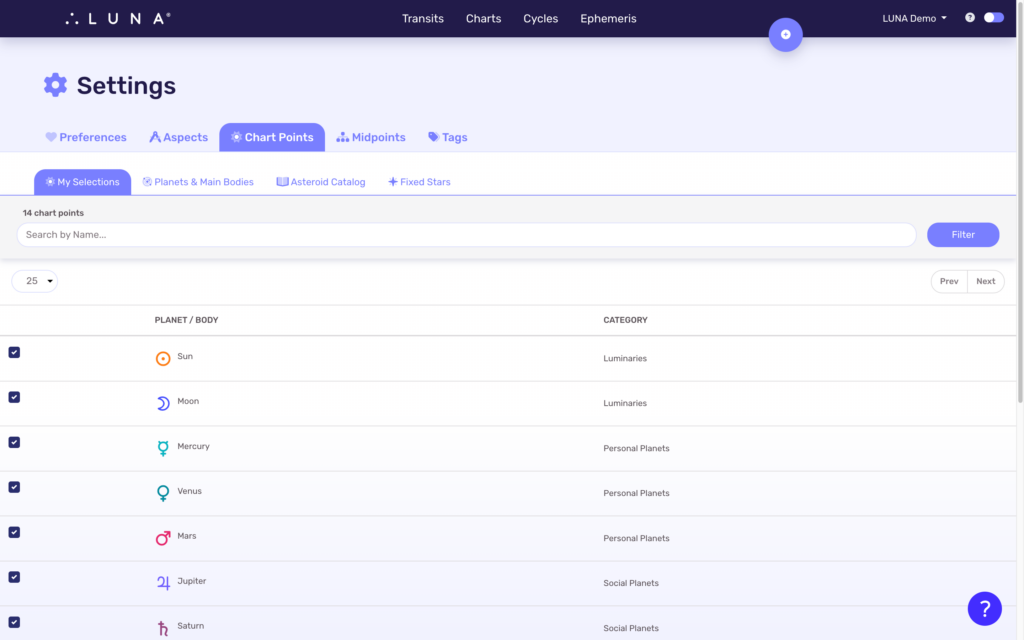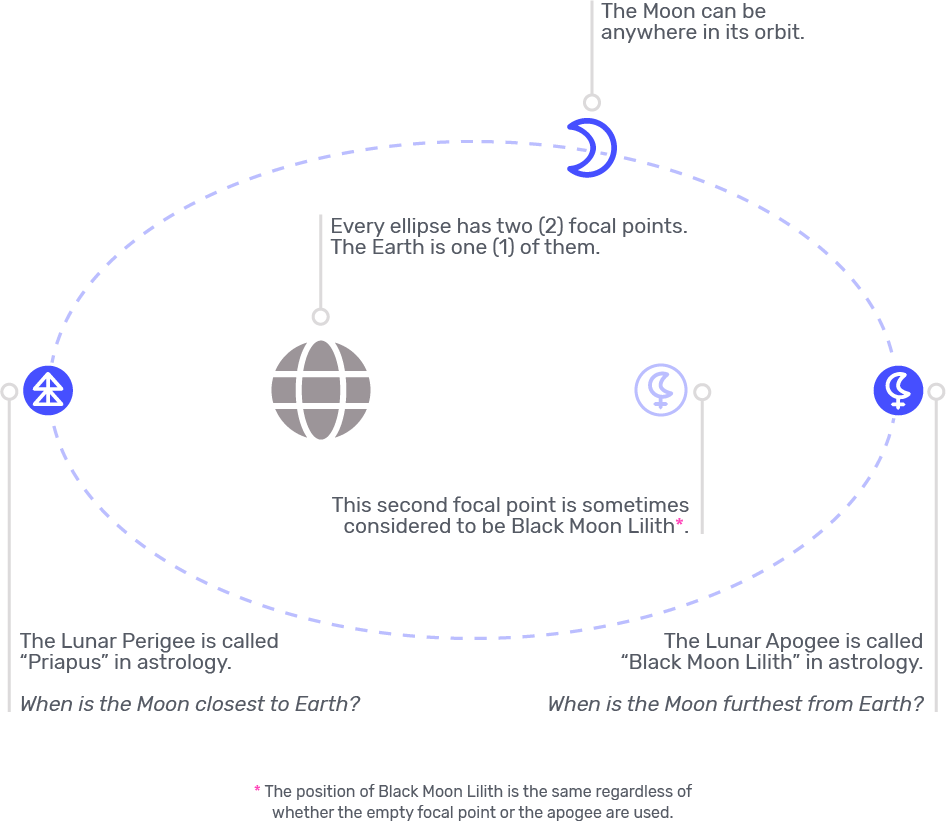LUNA supports the calculation of a huge number of chart points. We consider any point that can be displayed on your chart (including the planets) a “chart point”. You can select which chart points you want calculated for your charts:
- Login to your account if you’re not already logged in.
- [Desktop] Select your name from the upper-right of the screen or…
- [Mobile] Select the “more” link (3 dots) from the upper-right of the screen.
- A menu will display with a “Settings” link.
- Select that link to access your personal preferences.
- Select the “Chart Points” tab.

This is a sample of what the “Chart Points” settings screen looks like.
Chart Point Selections
LUNA organizes all of the available chart points under four (4) basic categories labeled by the tabs. You can search the chart points within each of the tabs by name; and choose to select which chart points you want displayed on your charts.
1. My Selections
This tab shows all of the chart points you currently have selected for display on your charts. You can uncheck any of the checkboxes next to the chart point to remove it from this list. To add it back (or to add a different chart point), navigate to the appropriate category tab and locate it there.
2. Planets & Main Bodies
The most common chart points such as the Planets, Lunar & Planetary Nodes, Chiron and the main asteroids can all be found under this tab. If any of these chart points is also selected for display on your charts, the checkbox will indicate this. You can check or uncheck any of the chart points to change your selection settings.
3. Asteroid Catalog
The Asteroid Catalog contains approximately 25,000 named asteroids, centaurs, dwarf planets and minor bodies. This list is updated on an ongoing basis so check this tab to view an exact number. You can choose from any of the named asteroids to display on your LUNA charts, and they will be treated just like any other chart point.
4. Fixed Stars
The Fixed Stars contains over 700 fixed stars, including the Galactic Center. This list is updated on an ongoing basis so check this tab to view an exact number. You can choose from any of the fixed stars to display on your LUNA charts, and they will be treated just like any other chart point.
Axis Points
LUNA provides one (1) chart point for any point that is part of a pair or axis. For instance, the Ascendant-Descendant axis can be shown or hidden by selecting that chart point.
LUNA will automatically calculate both ends of the axis and display them on charts.
Ascendant-Descendant
Note that in a quadrant-based house system such as Placidus and others, these axis points don’t display separately from the angles of the chart. However, enabling them in your settings allows LUNA to calculate aspects to these points.
When this point is turned off, LUNA will not calculate aspects to either the Ascendant or the Descendant.
If you’re using the 0° Aries system or the Whole Sign system, the Ascendant and Descendant will display as individual chart points just like the planets. They will still be 180° apart from each other although they won’t necessarily align with the heavy horizontal line that runs across the chart wheel.
Midheaven-IC
Note that in a quadrant-based house system such as Placidus and others, these axis points don’t display separately from the angles of the chart. However, enabling them in your settings allows LUNA to calculate aspects to these points.
When this point is turned off, LUNA will not calculate aspects to either the Midheaven or the IC.
If you’re using the 0° Aries system or the Whole Sign system, the Midheaven and IC will display as individual chart points just like the planets. They will still be 180° apart from each other although they won’t necessarily align with the heavy vertical line that runs across the chart wheel.
North & South Nodes
For all lunar and planetary nodes, LUNA will automatically display the opposite node when you select the nodal point for display.
For instance, if you select “Lunar True Nodes”, you will see both the north and south lunar nodes on your charts; and LUNA will calculate aspects to both of these chart points.
The same logic applies to the planetary nodes, although planetary nodes are not necessarily 180° apart from one another if you have selected to calculate them geocentrically.
Black Moon Lilith & Priapus
There is more than one (1) Lilith in astrology. However, LUNA uses the astronomical point known as the lunar apogee for Black Moon Lilith. The opposite point (the astronomical lunar perigee) is called Priapus. When viewed as a pair, the apogee and perigee are known as the lunar apsides.

LUNA provides three (3) different calculation methods for Black Moon Lilith and Priapus:
- Mean
- Osculating
- Natural
Mean
This calculation method is the most common one used by astrologers. The mean calculation assumes an average rate of motion of the Moon, which allows for a deviation from the actual lunar apogee of up to five degrees (5º).
Osculating
This calculation method is sometimes called “True”, but is not in actuality a true calculation of the position of the lunar apsides. In fact, it can deviate from the actual apogee’s position by up to thirty degrees (30º). This is because it is a mathematical construct which assumes that the Moon’s orbit is an ellipse. However, the Moon’s orbit is too irregular to truly be considered an ellipse.
Natural
This is the least common calculation method and is therefore not easy to find in other astrology software. It can be referred to as the “interpolated apsides” although its creator (Dieter Koch) prefers to call it the “Natural Apsides”. The important point to note here is that this method does not necessarily calculate the apogee and perigee in exact opposition to each other.
